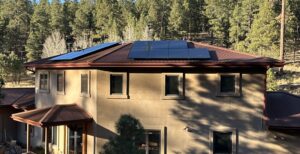The inverter plays a critical role in any solar power system design. It converts direct current (DC) produced by the solar panels and converts it into alternating current and makes it usable. Many consider it the “Brain” of the entire system. There are a lot of conversations out there about grid tie inverters and how micro-inverters used in hot climates such as Phoenix, AZ, don’t do as well or have higher failure rates than traditional string inverters. We’re going to break down why this is a myth, but first, we’ll start off with the basics: The difference between string inverters and micro-inverters.
A solar micro-inverter is a device used in photovoltaics that converts the direct current (DC) produced by a single solar module to alternating current (AC). The output from several micro-inverters is then fed into the electrical grid. A string inverter is a more traditional model that allows multiple solar modules to be connected in a series circuit to a DC electric cable, which is then connected to the grid by a single inverter box mounted on the wall. Because of this design, string inverters are easier and more time-efficient to install. However, several downsides come with that ease of installation. Since all of the solar modules are connected to one inverter, if just one of the panels is obstructed by shade, snow, etc., or goes off-line for any reason, it hinders the entire solar array’s energy production. Basically, a string-inverter connects a whole solar array to the grid at once, while micro-inverters connect each individual panel, making installation and monitoring a simple and accurate process. [1]
So now to the rumor that micro-inverters don’t do as well as string inverters in hot climates… This is a myth generally propagated by PV installers that have little to no experience using micro-inverters such as the ENPHASE IQ7, IQ7+,or IQ8, and it really can’t be further from the truth. In fact, there are numerous studies out there to prove this.
First of all, Enphase micro-inverters operate at a standard 120/240 volt rate and only produce up to 1.13 Amps per each unit, which actually keeps them cooler than string inverters. The micro-inverters are mounted on the roof alongside the solar modules. However, they are installed in the shade of each module and typically operate at 20˚F cooler than the surface of the modules. There is also significant airflow around each micro, which help them to maintain cooler operating temperatures. String inverters operate at higher amperages and voltages (up to 600 Volts DC) and therefore create a lot more internal heat than a micro-inverter because they have to do so much more work. They also typically do not have any internal cooling fans, so the only way string inverters can control their temperature is by cutting back on their production output – meaning cutting back on the amount of electricity they produce to stay within their set operating temperatures.
Enphase micro-inverters record their internal temperatures, along with other data, and store the information on the Enphase Enlighten monitoring platform. The internal temperature is measured inside the sealed micro-inverter. According to reports of this data, Enphase micro-inverters installed in even the hottest locations in the United States have never exceeded the maximum allowable internal temperature within their lifetimes and contrary to popular belief, do not have higher failure rates than micro-inverters in more temperate environments. A recent study of internal temperature data from 75,000 Enphase Microinverters in five of the hottest locations in the US found that, where some microinverters were operating near the upper-temperature limit, others in similar heat in nearby installations were reporting 50% cooler readings. This difference in internal temperature readings for the same product indicates that installation practices may have had an effect. Inadequate or incorrect installation procedures were used by those installers that may have seen failures of the Enphase product due to heat.
Another recent study done in some of the hottest climates in the harshest environments in Australia recorded data that backs up the same performance claims. A technical brief details the effect that high ambient temperatures have on internal temperatures reported by the micro-inverters. Over 67,000 data readings were gathered from more than 170 Enphase installations across Australia, including New South Wales, Queensland, Victoria, and Tasmania during January 2014. During the extreme temperatures of Australia’s hottest month of the year, all Enphase Microinverters operated continuously – demonstrating that they are suitable for installation on rooftops and under modules in some of the hottest climates available.
Ultimately, the use of Enphase Microinverters on solar arrays in hot climates (or really any climate!) will provide homeowners and solar installers peace of mind. Not only is the failure rate minimal, but if an Enphase Microinverter does go off-line, your Rooftop Solar installer (and yourself) are immediately notified of any problem by the included Enphase MyEnlighten monitoring system, and troubleshooting can begin immediately. This ensures that you are not without solar PV power production for months or more while you sift through your APS or SDG&E bills to see inconsistencies. The other advantage is that if a Micro does go down, then only a portion of your PV system loses productivity, whereas if your string inverter goes down, the entire PV system produces no power until the inverter is fixed or replaced. If your roof (or solar panel) has shading, a micro-inverter system is a cost effective option that helps level out production and increases your ROI over the years.It’s no wonder why Enphase Microinverters come standard with a 25-year warranty, as opposed to a standard 10-year warranty on typical string inverters.
Are you thinking of making the switch solar at your home or business? Get a free quote here, and we’ll point you in the right direction with a custom solar proposal to best suited your family’s needs at a great price.
Sources:
[1] GoGreenSolar – Blog
https://enphase.com/en-us/blog/featured-residential-array-enphase-beats-heat-valley-sun
https://enphase.com/en-us/success-stories/homeowner-residential/haleakala-solar
Micro-inverters Vs. String Inverters in Hot Climates



